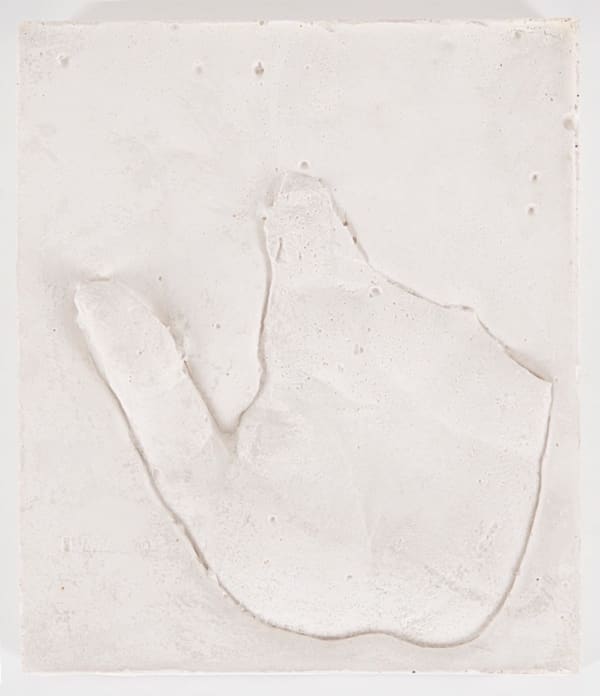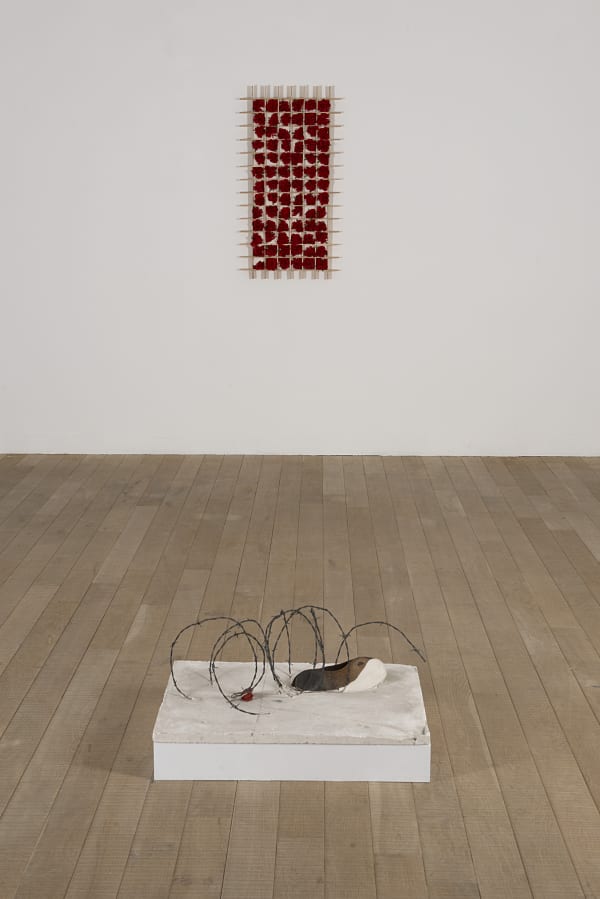In his Greek homeland, Vlassis Caniaris ranks among the most widely known artists of his generation. In 1958, he presented the first exhibition of abstract paintings to be held there, and adopted a critical position on political and social issues in his work throughout the country’s military dictatorship. While he is known and appraised among international artists, he has been almost forgotten by the wider art world.
On view in the first room is the installation “Urinals of History” that includes three human-scale plaster figures from 1980. The clothed scarecrow-like bodies are made from wire mesh and clothes and represent male figures urinating against a painted wall inscribed with red, blue and green letters reminiscent of political slogans on the walls of Athens during Nazi occupation or later during the military dictatorship and reminiscent of Caniaris’ series of paintings “Homage to the Walls of Athens”. The installation was first exhibited at Caniaris’ 1980 exhibition “Hélas-Hellas“ (Eng.: Alas-Greece) in Athens, which marked a breakthrough for the artist. Also in the first room is an object representing a hybrid between a child figure and a wastebasket entitled “Garbage Child 4”, and “Child’s room”, a large-scale assemblage interior representing an impoverished nursery (both 1974). In these seminal works Caniaris addresses issues of contemplation and observation and represent an acute vision of social, cultural and personal asymmetries for pathological symptoms in industrialized societies, such as the Gastarbeiter (Eng.: migrant worker). Caniaris described his sculptural figures as “witnesses”, and as a whole the installation produces a highly reflexive interweaving of reciprocal observer positions and roles, situating the artist as an observer who is always part of the observed situation, and who alter it with a radical subjectivity that includes an acceptance of his own limitations as an artist. Aware of this limitation, Caniaris imparted this to his viewers by locating them on the same representational plane as his subjects: as objects, observers, and participants simultaneously – occupying a radically open position the artist inhabited in his own life and work.
The second room of the exhibition is dedicated to Caniaris’ “Anti-dictatorial” series from 1969 to 1970, in which objects such as shoes, plastic carnations, children’s toys and barbed wire are immersed in plaster. The works were part of Caniaris’ solo exhibition at the Musée d’Art Moderne de la Ville de Paris in 1970 and can be seen as a metaphor for the state of Greek society ‘casted’ under military dictatorship and waiting to be set free. Reminiscent of the style of Arte Povera these works have been coined by Max Imdahl and Michael Fehr as Concrete Realism and show Caniaris’ formal developments beyond the picture frame.
While living in Rome (1956-1960), Caniaris’ practice still focused on two-dimensional images, drawing inspiration from the works of Giorgio de Chirico and symbolic realism. His turn towards the abstract dates to his time in Paris (1960-1967 and 1969-1973), when he was also seeking to dissolve the surface of his works and opened his practice to threedimensionality and assemblage. From his first “informal” compositions in 1956-1957 on newspapers and dripping on canvas, Caniaris gradually changed from the frame of the canvas to the space and image of the object.
The political situation in Greece – to which he returned in 1967 to participate in the popular resistance movement against the military leadership until he was forced to leave again in 1969 – and his experiences in Berlin with a DAAD grant (1973- 1975) heightened his interest in the aesthetics of sculpture and contributed to the growing socio-political dimension of his works. During this time there was also a growing global crisis concerning the numbers of migrant workers in Europe. Many of these workers from Southern Europe had been allowed to enter countries in the North to contribute in the Wirtschaftswunder (Eng.: economic miracle) in an attempt to rebuild their economies after the Second World War.
However after the 1973 oil crisis, these same countries began to close their borders in an attempt to protect their own citizens. A temporary immigrant himself, Caniaris was sensitive to this situation and brought theses issues together in his artistic practice. In the early 1970’s he began to focus on matters of national identity, social inequality and immigration, and produced during this period his most significant works. Using indigenous elements and found household objects such as used clothing and toys as materials, Caniaris gradually initiated to create a human form; a physical proposition: the person-object, which was not only a political or social subject but an ontological, existential figure. The figure of loneliness or marginality expressed through aesthetic means. Caniaris has been influencing a number of artists ever since.
 Vlassis CaniarisUrinal of History, 1980Environment with 3 standing figures made of metal frame and clothing, painted wall paper on canvasWall paper on canvas: 234 x 1007 cm
Vlassis CaniarisUrinal of History, 1980Environment with 3 standing figures made of metal frame and clothing, painted wall paper on canvasWall paper on canvas: 234 x 1007 cm Vlassis CaniarisGarbage Child, 1974Wire mesh, plastic, tape, shirt, fabric carnation, cigarette boxes, kodak film box, paper cup, paper103 x 47 x 16 cm (40.6 x 18.5 x 6.3 in.)Unique
Vlassis CaniarisGarbage Child, 1974Wire mesh, plastic, tape, shirt, fabric carnation, cigarette boxes, kodak film box, paper cup, paper103 x 47 x 16 cm (40.6 x 18.5 x 6.3 in.)Unique Vlassis CaniarisObserver, 1980Wire mesh, clothes, shoes, plastic145 x 51 x 39 cm (57.1 x 20.1 x 15.4 in.)Unique
Vlassis CaniarisObserver, 1980Wire mesh, clothes, shoes, plastic145 x 51 x 39 cm (57.1 x 20.1 x 15.4 in.)Unique Vlassis CaniarisChild's room, 1974Environment made of pasted newspapers and wallpaper, floor lamp, turned over table, curtains, carpet, 3 cups, jam jar, painted plywood boards, metal boar150 x 256 x 145 cm (59.1 x 100.8 x 57.1 in.)Unique
Vlassis CaniarisChild's room, 1974Environment made of pasted newspapers and wallpaper, floor lamp, turned over table, curtains, carpet, 3 cups, jam jar, painted plywood boards, metal boar150 x 256 x 145 cm (59.1 x 100.8 x 57.1 in.)Unique Vlassis CaniarisSpace Within Space, 1960Metal mesh on wooden frame, with cloth and wire65 x 81 x 3.5 cm (25.6 x 31.9 x 1.4 in.)Unique
Vlassis CaniarisSpace Within Space, 1960Metal mesh on wooden frame, with cloth and wire65 x 81 x 3.5 cm (25.6 x 31.9 x 1.4 in.)Unique Vlassis CaniarisUntitled, 1969-1975Plaster, wood, plastic carnations100 x 53 x 4.5 cm (39.4 x 20.9 x 1.8 in.)Ed. 52/60 (LAST)
Vlassis CaniarisUntitled, 1969-1975Plaster, wood, plastic carnations100 x 53 x 4.5 cm (39.4 x 20.9 x 1.8 in.)Ed. 52/60 (LAST) Vlassis CaniarisTrap, 1969Plaster, shoe, barbed wire, fabric carnation48 x 70 x 26 cm (18.9 x 27.6 x 10.2 in.)Unique
Vlassis CaniarisTrap, 1969Plaster, shoe, barbed wire, fabric carnation48 x 70 x 26 cm (18.9 x 27.6 x 10.2 in.)Unique Vlassis CaniarisFossil, 1970Plaster19 x 16 x 4 cm (7.5 x 6.3 x 1.6 in.)Unique
Vlassis CaniarisFossil, 1970Plaster19 x 16 x 4 cm (7.5 x 6.3 x 1.6 in.)Unique Vlassis CaniarisSurface - Space, 1960Plaster-soaked cloth and metal mesh44 x 65 x 3 cm (17.3 x 25.6 x 1.2 in.)Unique
Vlassis CaniarisSurface - Space, 1960Plaster-soaked cloth and metal mesh44 x 65 x 3 cm (17.3 x 25.6 x 1.2 in.)Unique















